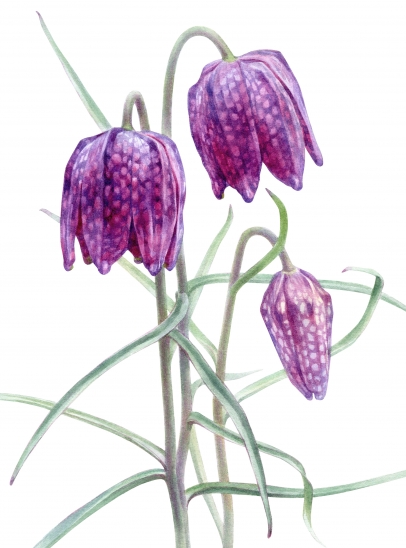Chocolate Lilies
I love obscure, wild and unusual edible plants. (In fact, I have planted many native species of edible wild plants, bulbs and mushrooms in my kitchen garden at home and in my forest garden at the cottage.) And chocolate lilies fit right into this category.
A lily by many other names
Chocolate lily is a common name for up to three varieties of Fritillaria. (Of note: they are a completely different species than the small plant, Dichopogon strictus from Australia that shares the common name, chocolate lily.) Other common names are wild rice, northern rice root, rice root fritillary, Kamchatka fritillary, checker lily (actually a closely related species) and mission bells. Fritillaria camschatcensis and Fritillaria lanceolata are the most common on the coast, with Fritillaria affinis more often found in the interior of B.C.
Chocolate lilies get their name more from the colour of their flower petals than their scent—Fritillaria flowers tend to have a smell closer to doo-doo than cocoa. The flowers are a dark purple with brown or yellow, giving this nodding lily it’s mottled or snakeskin type pattern, and six petals or tepals. All three types found in B.C. bloom in early spring on 20–50 cm tall green stems with elegant, thin leaves and feature small white (and sometimes purple) bulbs that grow many small offshoot bulbs that look like grains of rice.
The taste of local history
These sweet, dark lilies are natural to the Pacific Northwest and were a regular part of Coast and Interior Salish people’s seasonal diets, as both the bulb and bulblets can all be eaten. The bulbs grow close to the top of the soil, so Indigenous ancestors used strong sticks, yew wood spades or their bare hands to gently dig them out of the ground without damaging the delicate bulbs.
Each group of Indigenous people had their own special ways of preparing the Fritilarria bulbs. With a slightly bitter flavour, this starchy root could be eaten raw or cooked. They could be boiled and stored in seal oil, mashed, added to soups or dried and ground into flour. Often, the rice-like bulbs were soaked overnight before cooking to reduce their bitterness. To preserve the lily bulbs through winter, they were usually partially dried and put in cold storage or cleaned and stored in oil or seal grease.
To prepare them yourself, try the tiny, cleaned “rice” raw, in salad or alongside baked salmon. To cook them, simmer gently for 5–15 minutes until cooked through. Serve with butter, salt and pepper, as you would boiled potatoes. They are a great addition added to soup too—but they don’t need long, so add them along with the seafood or in the last 10–15 minutes of cooking.
Handle with patience and care
Chocolate lilies tend to grow in Garry oak meadows and in moist, well-drained sunny fields, slopes and at the edges of tidal flats, but are not as common to find in the wild as they once were, because of overharvesting and development of natural areas. If you find some while foraging and choose to pick some, be sure to take only a small percentage to prevent overharvesting—and when picking the bulb clump up, leave a few rice-sized mini bulbs in the ground to regrow, because once the bulbs are harvested, the plant is gone.
Because these are a diminishing wildflower, they are best planted and grown in your own garden if you want to harvest the bulbs to eat. If you want to try growing them, they can be grown from seed, bulblet or large bulb. Choose a spot with full sun to partial shade in well-drained but moisture-retentive soil that is neutral or slightly acidic. Ideally, they should be planted in mid- to late-fall, but they can also be planted in early spring, as soon as the ground can be worked.
Water often during the dryer months, especially until the tiny lilies get established. Started from seed, these small Fritillaria can take up to 3–5 years to bloom, but planted from bulb, they will bloom much sooner. Once the greens are growing well, you can (and should) divide the bulbs every 2–3 years, depending on the density and health of the growth, to cultivate more flowers and bulbs. The bulbs are best harvested just after blooming (usually late spring, depending on where you live) when they are most full of nutrients, though they can be harvested right through to late fall.





